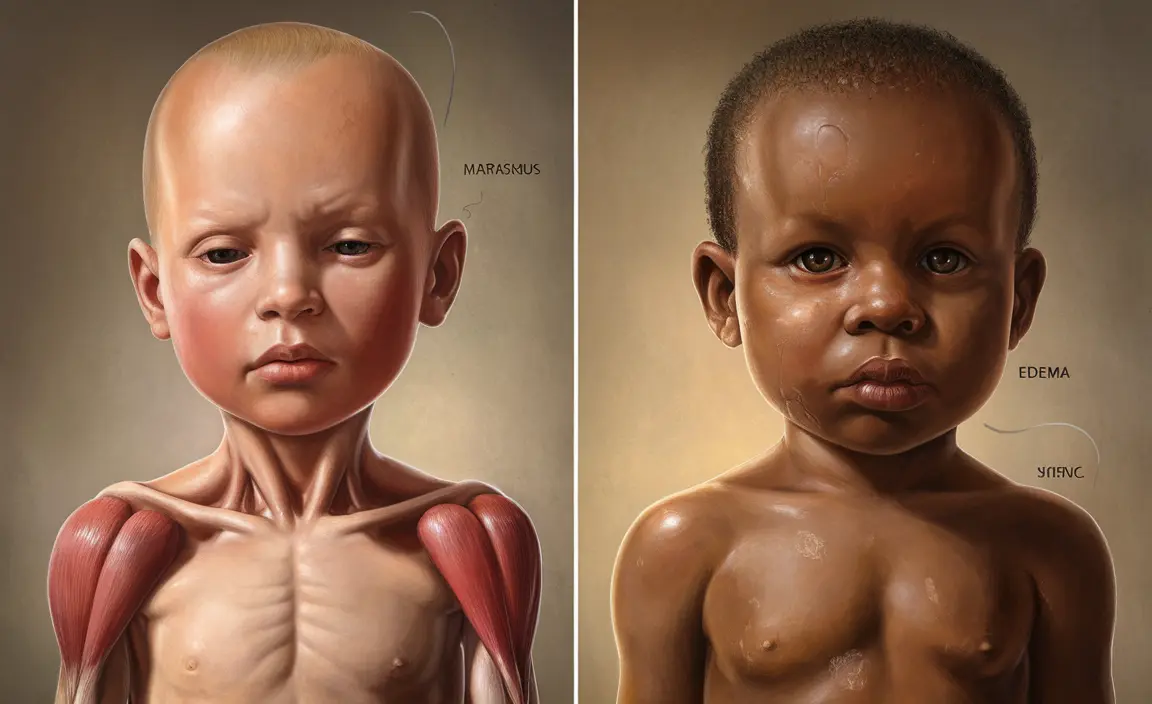Severe malnutrition in children can manifest in two distinct forms: marasmus and kwashiorkor. These conditions represent different ends of the protein-energy malnutrition spectrum, each with unique characteristics and treatment approaches. Understanding these differences is crucial for healthcare providers and caregivers to ensure proper diagnosis and treatment.
While both conditions stem from inadequate nutrition, their presentation, underlying causes, and management strategies differ significantly. This comprehensive guide explores the key distinctions between marasmus and kwashiorkor, their impacts on child health, and essential prevention strategies.
Clinical Characteristics and Physical Presentation
Marasmus and kwashiorkor present with distinctly different physical characteristics, making them relatively easy to distinguish clinically:
Marasmus Features
Children with marasmus typically show:
- Severe muscle wasting
- Minimal to no subcutaneous fat
- Visible rib cage and bones
- Loose, wrinkled skin
- Alert and irritable behavior
- Severe growth stunting
Kwashiorkor Features
Children with kwashiorkor typically present with:
- Bilateral pitting edema
- Distended abdomen
- Changes in hair color and texture
- Skin lesions and discoloration
- Apathetic behavior
- Moon-like facial features
Nutritional Deficiency Patterns
The underlying nutritional deficiencies in these conditions differ significantly, leading to their distinct presentations:
Marasmus Nutritional Profile
Marasmus results from overall caloric deficiency, including:
- Insufficient total energy intake
- Inadequate protein consumption
- Reduced carbohydrate intake
- Limited fat consumption
Kwashiorkor Nutritional Profile
Kwashiorkor primarily stems from protein deficiency, characterized by:
- Adequate or near-adequate caloric intake
- Severe protein deficiency
- Diet high in carbohydrates
- Insufficient essential amino acids
Diagnosis and Treatment Approaches
The treatment strategies for these conditions require different approaches, though both necessitate careful medical supervision:
Treating Marasmus
Treatment focuses on gradual refeeding with:
- Carefully calculated caloric increases
- Balanced macro and micronutrient supplementation
- Regular monitoring of weight gain
- Prevention of refeeding syndrome
Treating Kwashiorkor
Management requires special attention to:
- Protein repletion
- Management of edema
- Correction of electrolyte imbalances
- Treatment of concurrent infections
Prevention Strategies
Preventing these severe forms of malnutrition requires comprehensive approaches:
- Regular growth monitoring
- Adequate maternal nutrition during pregnancy
- Proper breastfeeding practices
- Appropriate complementary feeding
- Access to diverse, nutrient-rich foods
- Community education and support
Frequently Asked Questions
What are the main differences between marasmus and kwashiorkor in terms of symptoms and causes?
Marasmus results from overall caloric deficiency, presenting with severe wasting and minimal body fat. Kwashiorkor primarily stems from protein deficiency while maintaining adequate calories, characterized by edema, distended abdomen, and skin changes.
How do you diagnose and treat marasmus versus kwashiorkor?
Diagnosis is primarily clinical, based on physical appearance and symptoms. Treatment for marasmus focuses on gradual caloric repletion, while kwashiorkor treatment emphasizes protein restoration and edema management.
What are the key nutritional deficiencies that lead to marasmus and kwashiorkor?
Marasmus develops from overall insufficient caloric intake affecting all macronutrients. Kwashiorkor results primarily from severe protein deficiency despite potentially adequate caloric intake from carbohydrates.
What can parents do to prevent marasmus and kwashiorkor in their children?
Parents should ensure proper breastfeeding, appropriate complementary feeding, regular growth monitoring, and access to diverse, nutrient-rich foods. Educational support and regular healthcare visits are also crucial.
How do kwashiorkor and marasmus affect a child's growth and development long-term?
Both conditions can lead to stunted growth, delayed development, cognitive impairment, and increased susceptibility to infections. Early intervention is crucial to minimize long-term impacts on physical and cognitive development.




